Max. storage capacity
This item characterizes the maximum capabilities of the device for connecting drives. This way you can understand how much maximum memory can be added to the NAS server.
CPU
The model and specifications of the processor installed in the NAS server. The speed of the device largely depends on these characteristics, primarily the clock frequency. However, in fact, this parameter is often more of a reference value: simple everyday tasks (say, FTP and print servers, see "Software Features") do not require high computing power. But for working with extensive databases (see ibid.), a “faster” processor may be useful.
CPU cores
The number of cores provided in the processor of the NAS server.
Initially, each core is a computing module designed to execute one sequence of instructions. Accordingly, multiple cores make it possible to work simultaneously with multiple data streams, which improves flow Rate - especially when processing multiple tasks at the same time. Also, in modern CPUs, multithreading technologies are increasingly being used, which allow loading each core with two sequences of commands at once. During the inevitable pauses in the execution of one of the threads, the kernel does not idle, but works with another sequence. As a result, the total number of threads in such processors is twice the number of cores; this scheme of work even more noticeably improves flow Rate.
It is also worth remembering that the overall capabilities of the processor are highly dependent on a number of other characteristics - microarchitecture, clock speed, support for special functions, etc. This means that a large number of cores does not in itself guarantee high flow Rate: for example, an inexpensive mobile
processor on 4 cores may well be "weaker" than an advanced desktop chip
with only 2 cores. However, if we are talking about a CPU with a similar specialization and clock speed, then a solution with a large number of cores (
6 cores,
8 cores, or ev
...en more) and multithreading support usually turns out to be more productive.CPU speed
Clock speed of the processor installed in the NAS server.
The clock frequency is the frequency of the built-in oscillator, according to which all operations performed by the processor are synchronized. The higher this frequency, the more operations per second the CPU can perform and the easier it is to provide high computing power in it. However, note that the actual speed of the processor depends on many other features — the number of cores (see above), microarchitecture, volumes of the built-in cache memory, etc. So, only chips with similar characteristics and purpose can be directly compared by clock frequency ( desktop/mobile) and price category.
Control
How to access NAS server management.
— Web interface. With this control, access to the settings is carried out through a regular browser: by connecting the NAS to a computer network, the user enters a special service address specified in the device documentation and gets to a web page through which control is carried out. One of the key advantages of this option is the ability to control it from any computer on the network, or even remotely via the Internet: it is enough to know the address and login / password. Due to simplicity and convenience, the vast majority of modern NAS servers are managed through a web interface.
— Utility. Server management through a special service programme (utility) installed on the host computer. This option is considered obsolete and is very rare. The main reason is the inconvenience compared to the web interface (see above): you need to spend time installing and configuring the utility, while the browser on most modern PCs is available by default.
Power consumption
The amount of power consumed by the NAS server during normal operation. Most often, we are talking about maximum power consumption — with all the occupied slots for drives, under high load.
Modern NAS, even high-performance ones, have rather modest power consumption — even among professional models with 10 or more drives, this figure rarely exceeds 1 kW. So there are no problems with connecting to a 230 V network. However, energy consumption information can be useful for some special applications, primarily for estimating the load on UPSs, emergency generators, stabilizers, and other special equipment.
Noise level
The noise level produced by the device during operation. These data will be useful, first of all, to those who are trying to reduce the noise level as much as possible and, as they say, “fight for every decibel”. However, it is worth noting here that manufacturers can cheat and indicate the noise level for different modes.

